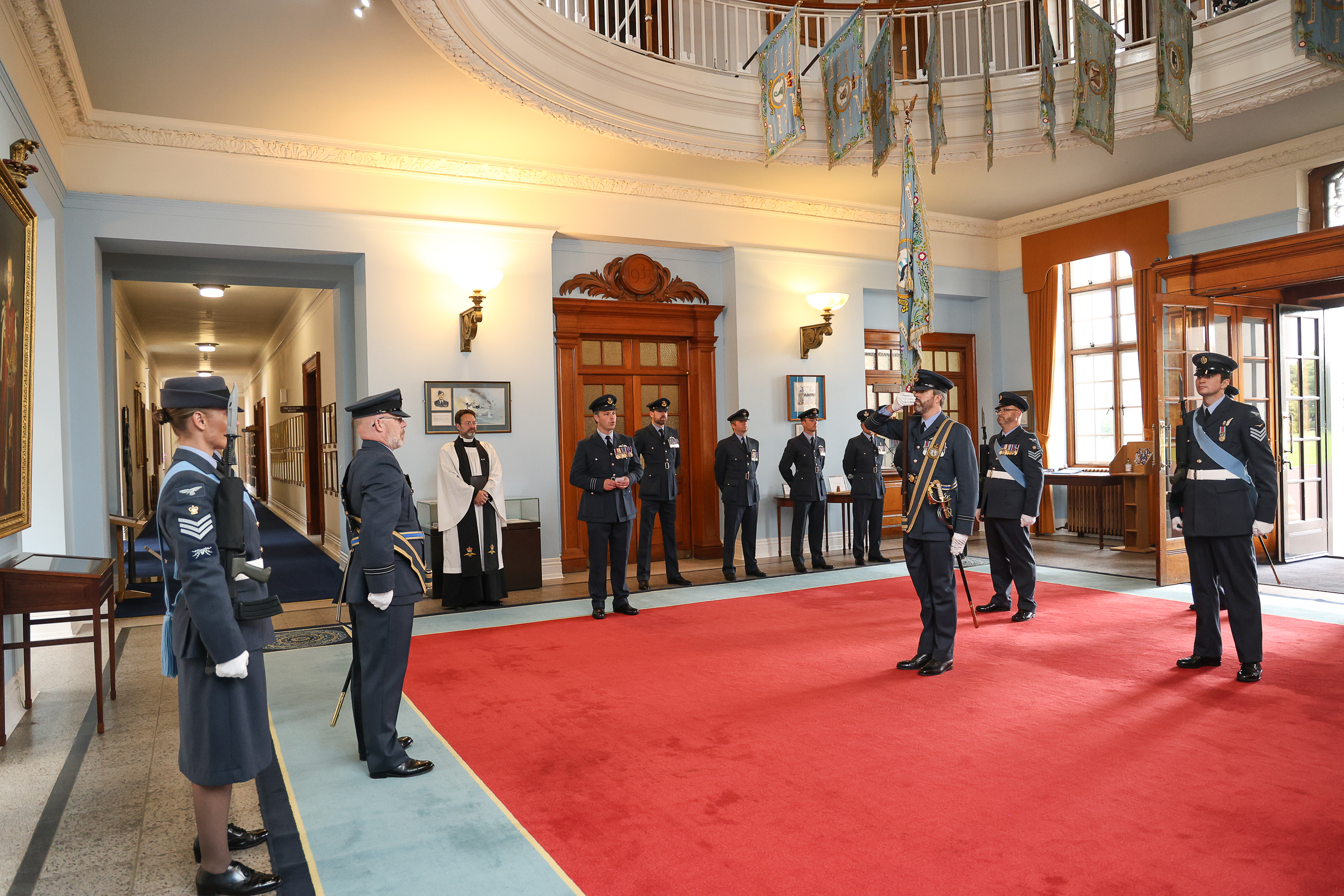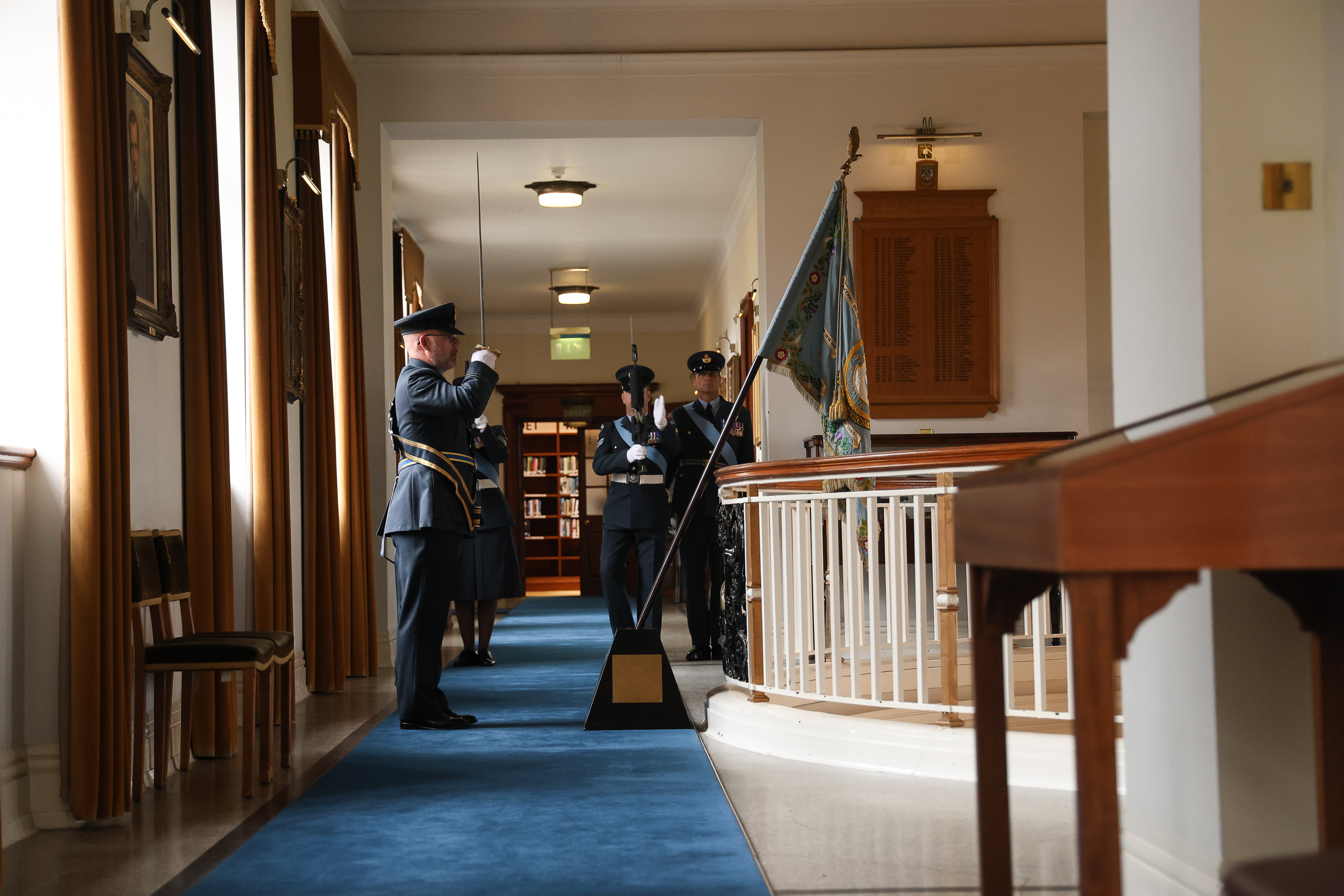On 31 July 2023, the Standard of Number 47 Squadron was formally laid-up in the Rotunda of College Hall Officers’ Mess at
Royal Air Force College Cranwell.

Following the retirement of the Hercules in June 2023, it was directed that Number 47 Squadron should disband in September 2023, ready to be reformed at the first opportunity. As part of the disbandment process, the standard was laid up in a short ceremony involving members of Number 47 Squadron and the RAF College Standard party. The 47 Squadron standard bearer was Flight Lieutenant Steve Noble, and the ceremony was officiated by the RAF College Warrant Officer, WO Jim Dick. On disbandment, Number 47 Squadron will be the eighth most senior squadron in the Royal Air Force, having also been awarded more battle honours than any other fixed wing RAF squadron this century.

Number 47 Squadron RAF, was formed at Beverley in Yorkshire on 1 March 1916 as an air defence unit, saw service in Russia in 1919, as a bomber squadron in Egypt and Sudan from 1920 to 1942, as a torpedo bomber squadron in the Mediterranean until 1944 and for ground attack in the Far East until 1946. Its role as an air transport unit began in Palestine in 1946, where it was equipped with the Halifax and later the Hastings. Number 47 Squadron flew more than 3000 missions in the Berlin Airlift. After being re-equipped with the Beverley in 1956, the Squadron began its association with the Hercules in 1968. Since this time, the Squadron has provided air mobility support to operations and disaster relief all over the world. Significant events include disaster relief in Nepal, Ethiopia, Sudan and Turkey, operations in the Falklands, the Gulf, the Balkans (including almost 2000 sorties in the Sarajevo Airlift), and Iraq from 2003. In 2001, 47 Squadron Hercules were the first UK aircraft to land in Afghanistan, in 2014 Operation SHADER began with a 47 Squadron airdrop to Mount Sinjar. In 2021 the last aircraft to leave Kabul during Operation PITTING was a 47 Squadron Hercules. In 2023 the Squadron supported disaster relief in Turkey, evacuated people from Sudan, and continued its commitment to Operation SHADER until 4 June 2023. The final formal task for the Squadron was the King’s Birthday Flypast on 17 June 2023. The Squadron motto “Nili Nomen Roboris Omen” means the “The name of the Nile will be an omen of your strength” and was awarded in 1938 by King George VI, replacing an earlier unofficial motto: “Sans Peur”.

Officer Commanding Number 47 Squadron, Wing Commander James Sjoberg said:
“It was an honour to attend the laying-up ceremony of the 47 Squadron Standard. A superb ceremony by the RAF College team rounded off a period of fabulous celebrations of the Hercules and Number 47 Squadron. Whilst it was undoubtedly a sad moment to watch the standard being rested ahead of the Squadron’s formal disbandment in September, I am reassured that the Squadron will be re-instated to an appropriate role at the first opportunity. I’d like to offer my thanks once more to the amazing people of 47 Squadron, and their families, who have achieved so much over the long and proud history of Number 47 Squadron.”
Wing Commander James Sjoberg
Officer Commanding Number 47 Squadron

NUMBER 47 SQUADRON RAF
No. 47 Squadron, Royal Flying Corps was formed at Beverley, Yorkshire on 1 March 1916. The Squadron was initially designated for home defence, but was not issued with any aircraft until 13 April, when four Royal Aircraft Factory BE2Cs were transferred from 15 Reserve Squadron.
The officer appointed to command 47 Squadron was Major F.G. Small, who was an experienced pilot, having deployed to France in the first wave of RFC squadrons in August 1914. He took part in what is thought to be the first example of air-to-air combat, when he and his observer forced down a German aircraft. He led the squadron for only a few months, primarily training pilots and observers, but also strafing German Zeppelin airships conducting bombing raids across the UK.
By mid-August, now under the command of Major Wigram, the Squadron’s role was changing with newly qualified students being posted to No. 47 to carry out photo reconnaissance, bombing practice and artillery cooperation. With this new skillset, No. 47 Squadron deployed overseas on 5 September, not returning to the UK for another 30 years.
Greece (September 1916 – April 1919). Support the Serbian army fighting off invasions by Austro-Hungarian and Bulgarian Forces.
Russia (April 1919 – October 1919). Support the White Russian Army by providing the sole air co-operation for over one million soldiers.
Externally, No. 47 Squadron was disbanded in October 1919 to become ‘A’ Squadron of the Russian 7th Division, ensuring there was no official RAF involvement in the war in Southern Russia and the Ukraine. The Squadron fought under its own flag that is still flown today outside the 47 Squadron Headquarters and worn proudly as a badge. The original colours were red, blue, and white (the colours of the pre-revolution Russian flag), but a shortage of white ribbon locally meant that the white was substituted for yellow.
Egypt & Sudan (February 1920 – September 1939). Support the governments of Egypt and Sudan, carrying out photoreconnaissance, policing, customs control, anti-slavery patrols, cargo, and personnel movements.
Newly reformed in Egypt as part of Royal Air Force restructure post-WW1, No. 47 Squadron adopted an unofficial crest. The stepped pyramid temple of Zoser with the sun setting behind it over an RAF eagle with the motto ‘Sans Peur’ (Without Fear) below. This was replaced in 1938 by an official heraldic design, which shows the head of a demoiselle crane, a migratory bird found in Russia and Sudan, over blue and white waves representing the river Nile, with the Latin motto ‘Nili Nomen Roboris Omen’ (The name of the Nile is an Omen of our Strength).
Sudan (May 1940 – December 1941). East-African ‘Advanced Striking Force’ carrying out long-range bombing raids on Italian targets.
Egypt & Libya (December 1941 – June 1943). Coastal patrol and anti-submarine surveillance.
Tunisia (June 1943 – Oct 1943). Long-range anti-shipping strikes to Sicily and Western Italy, Sardinia & Corsica.
Libya (October 1943 – March 1944). Support the allied effort to free the Mediterranean from Nazi occupation.
India & Burma (March 1944 – March 1946). Protect India from Japanese invasion and roll their frontline back, away from the Bay of Bengal. Liberate Allied POW post-war.
Palestine (September 1946). Transport & airdrop of equipment and parachutists.
United Kingdom (September 1946 -November 1948). Transport & airdrop of equipment and parachutists.
Germany (November 1948 – August 1949). Berlin Airlift.
United Kingdom (August 1949 – October 1967). Heavy-lift transport.
United Kingdom (February 1968 – June 2023). Operate the C-130 Hercules for transport and the airdrop of equipment and parachutists.
Words taken from ‘Under Their Own Flag – A History of 47 Squadron’ by Owen Clark.
NUMBER 47 SQUADRON RAF - BATTLE HONOURS
1916 – 1918 MACEDONIA
1940 – 1941 EAST AFRICA
1942 EGYPT AND LIBYA
1942 – 1943 MEDITERANIAN
1945 BURMA
1982 SOUTH ATLANTIC
1991 GULF
2003 – 2011 IRAQ
2011 LIBYA
2001 – 2014 AFGHANISTAN
Visit the Royal Air Force website
Visit the Royal Air Force Recruitment website to 'Find Your Role'.











